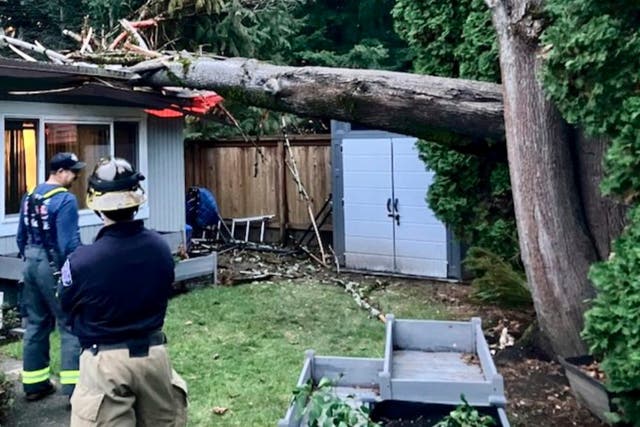
At least one person has died after a major storm swept across the north-west US, battering the region with strong winds and rain and causing widespread power outages.
The US Weather Prediction Centre warned of excessive rainfall through until Friday and hurricane-force wind warnings are in effect as the strongest atmospheric river – a large plume of moisture – that California and the Pacific North-west has seen this season overwhelms the region.
The storm system is considered a “bomb cyclone”, which occurs when a cyclone intensifies rapidly.
Downed trees have struck homes and littered roads across north-west Washington.

In Lynnwood, Washington, a woman died on Tuesday night when a large tree fell on a homeless encampment, South County Fire said in a statement on X.
In Seattle, a tree fell onto a vehicle, temporarily trapping a person inside, the Seattle Fire Department reported. The agency later said the individual is in stable condition.
“Trees are coming down all over the city and falling onto homes,” the fire department in Bellevue, about 10 miles east of Seattle, posted on the social platform X.
“If you can, go to the lowest floor and stay away from windows. Do not go outside if you can avoid it.”
Early Wednesday, more than 600,000 houses in Washington State were reported to be without power on poweroutage.us.
But the number of outage reports fluctuated wildly throughout the evening likely due in part to several weather and utility agencies struggling to report information on the storm because of internet outages and other technical problems.
It was not clear if that figure was accurate. More than 15,000 had lost power in Oregon and nearly 19,000 in California.
For those of you on the west coast: During high winds, trees can become dangerous objects. Stay safe by avoiding exterior rooms and windows and by using caution when driving. Prevent damage to your property by trimming loose branches and parking away from trees.… pic.twitter.com/Ue8IZJGMl6
— National Weather Service (@NWS) November 20, 2024
As of 8pm, the peak wind speed was in Canadian waters, where gusts of 101mph were reported off the coast of Vancouver Island, according to the National Weather Service in Seattle.
Along the Oregon coast, there were wind gusts as high at 79mph on Tuesday evening, according to the National Weather Service in Medford, Oregon, while wind speed of 77mph was recorded at Mount Rainier in Washington.
Winds were expected to increase in western Washington throughout the evening, the weather service said.
The US National Weather Service warned people on the West Coast about the danger of trees during high winds, posting on X: “Stay safe by avoiding exterior rooms and windows and by using caution when driving”.
In northern California, flood and high wind watches were in effect, with up to 8in of rain predicted for parts of the San Francisco Bay Area, North Coast and Sacramento Valley.
A 945 mb low pressure system continues to churn about 300 miles west of the Olympic Peninsula per the coordinated 00z (4 pm PST) surface analysis with @NWSOPC. Heavy rain, gusty winds, and mountain snow will continue across the Northwest through tomorrow as the system weakens. pic.twitter.com/lexILCNAk8
— NWS Weather Prediction Center (@NWSWPC) November 20, 2024
Dangerous flash flooding, rock slides and debris flows were expected, according to the National Weather Service Weather Prediction Centre.
A winter storm watch was issued for the northern Sierra Nevada above 3,500 feet (1,066 meters), where 15in of snow was possible over two days. Wind gusts could top 75mph in mountain areas, forecasters said.
The National Weather Service issued a flood watch for parts of southwestern Oregon through until Friday evening, while rough winds and seas halted a ferry route in north-western Washington between Port Townsend and Coupeville.
A blizzard warning was issued for the majority of the Cascades in Washington, including Mount Rainier National Park, starting on Tuesday afternoon, with up to a foot of snow and wind gusts up to 60mph, according to the weather service in Seattle. Travel across passes could be difficult if not impossible.


Why are you making commenting on The Herald only available to subscribers?
It should have been a safe space for informed debate, somewhere for readers to discuss issues around the biggest stories of the day, but all too often the below the line comments on most websites have become bogged down by off-topic discussions and abuse.
heraldscotland.com is tackling this problem by allowing only subscribers to comment.
We are doing this to improve the experience for our loyal readers and we believe it will reduce the ability of trolls and troublemakers, who occasionally find their way onto our site, to abuse our journalists and readers. We also hope it will help the comments section fulfil its promise as a part of Scotland's conversation with itself.
We are lucky at The Herald. We are read by an informed, educated readership who can add their knowledge and insights to our stories.
That is invaluable.
We are making the subscriber-only change to support our valued readers, who tell us they don't want the site cluttered up with irrelevant comments, untruths and abuse.
In the past, the journalist’s job was to collect and distribute information to the audience. Technology means that readers can shape a discussion. We look forward to hearing from you on heraldscotland.com
Comments & Moderation
Readers’ comments: You are personally liable for the content of any comments you upload to this website, so please act responsibly. We do not pre-moderate or monitor readers’ comments appearing on our websites, but we do post-moderate in response to complaints we receive or otherwise when a potential problem comes to our attention. You can make a complaint by using the ‘report this post’ link . We may then apply our discretion under the user terms to amend or delete comments.
Post moderation is undertaken full-time 9am-6pm on weekdays, and on a part-time basis outwith those hours.
Read the rules here